27.07 to 2.08.2009, 6 days, (practical) currency rate 1 € = 2600 S (Som)

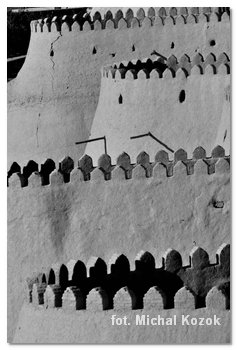 highlights – a nice custom officer greeted me when I was entering the Uzbekistan. He said in English that I must fill a custom declaration form, and he later will search my backpack to find out if everything is on my declaration form. My form was ok, but all began when he has found my knife, GPS, two SD camera cards, my USA visa – I was suspected for espionage. I just smiled and answered all the questions, after an hour I was released. Moment later we met another problem - in this country you shouldn't change your money in the bank, exchange office or hotel – the conversion rate is very low. Fortunately black market is working well, usually near the bazaar (or ask the taxi drivers). Dollar had much better rate than euro (for 10 € you get 11 $, but normally should be 14 $). In the text below I used a theoretical euro rate (converted value from exchanged in black market US dollars).
highlights – a nice custom officer greeted me when I was entering the Uzbekistan. He said in English that I must fill a custom declaration form, and he later will search my backpack to find out if everything is on my declaration form. My form was ok, but all began when he has found my knife, GPS, two SD camera cards, my USA visa – I was suspected for espionage. I just smiled and answered all the questions, after an hour I was released. Moment later we met another problem - in this country you shouldn't change your money in the bank, exchange office or hotel – the conversion rate is very low. Fortunately black market is working well, usually near the bazaar (or ask the taxi drivers). Dollar had much better rate than euro (for 10 € you get 11 $, but normally should be 14 $). In the text below I used a theoretical euro rate (converted value from exchanged in black market US dollars).
Another difficulties while travel in Uzbekistan is the mandatory registration. If you spend a night in an licensed hotel, such registration must be done by the owner. When check out we should got back from him our card with dates, stamps and signatures. So, it is not so bad, but we wanted to sleep in the wild. Then one of the option is to find the immigration office (OVIR) or the police station and sign up with them. But in this country it's better to avoid the police. You should also be careful when sleeping in a private home - after all, we should not give the address of its owner (usually the host is not aware of the absurdity and illegality of his hospitality), because it could cause him unnecessary problems. We decided for the second option - we slept in a tent or used the hospitality, and after it we asked the hostel owner to add few dates from the past - it worked without a problem. Despite everything we hadn't covered on paper all nights we spent in Uzbekistan. However, good news proved to be true that at the border no one asked us for our registration card.
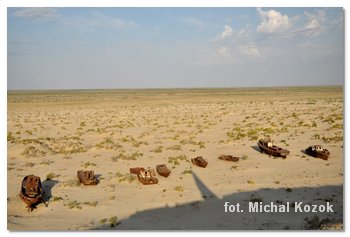 For centuries wonderful Amu- Darya River quietly made its way to the mouth of the Aral Sea. Suddenly the “great” Soviet Union scientists agreed to “cut the river alive”. They were aware of the ecological consequences, but for Moscow the only importance was income, and in the sixties the cotton was a pretty good business. So they dug several thousand kilometers long irrigation canals, where “blood” of Amu-Darya has flown. The river was dying, until finally there was no water in anymore. The same happened to the Syr-Darya River in Kazakhstan.
For centuries wonderful Amu- Darya River quietly made its way to the mouth of the Aral Sea. Suddenly the “great” Soviet Union scientists agreed to “cut the river alive”. They were aware of the ecological consequences, but for Moscow the only importance was income, and in the sixties the cotton was a pretty good business. So they dug several thousand kilometers long irrigation canals, where “blood” of Amu-Darya has flown. The river was dying, until finally there was no water in anymore. The same happened to the Syr-Darya River in Kazakhstan.
We went to Moynaq, the fishing village which in the sixties was lying on the coast of blue water lake, the fourth-largest in the world. Now the view is pathetic - on the sand under the cliffs there are rusted fishing boats wrecks. Lookout point is located near the Oybek hostel, just next to high concrete statue (War Memorial). It is in the eastern part of town, so I recommend to be there at sunset. You can go down the cliff to the former lake bed and walk among the wrecks, get inside them, take some pictures. There are 8 boats grouped, and a few hundred meters away to the south there are two more, much larger ones. We pitched a tent near the boats on the sandy bottom of the lake. You can also go back to town (700 meters), cross the main street to get near the old, abandoned canned fish factory - it's also a silent witness of this tragic event. Continuing walk from the main road to the east, we arrived on the other side of the former Aral Sea, as Moynaq is located on a narrow peninsula. Here we also could find a few more wrecks, but they are already so destroyed (or stolen for scrap) that it not much left to see. 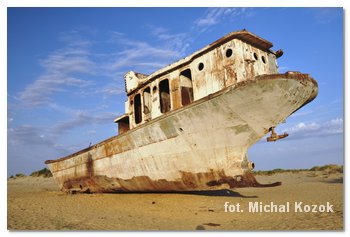 Returning to the main road and continuing the walk in a southerly direction, after about 30 minutes you get to the town museum (across the street from the fishing boat monument). It's nothing special (there is no fixed entry fee, just give a donation), except more than a dozen old photographs - reflect the atmosphere of town "transformation".
Returning to the main road and continuing the walk in a southerly direction, after about 30 minutes you get to the town museum (across the street from the fishing boat monument). It's nothing special (there is no fixed entry fee, just give a donation), except more than a dozen old photographs - reflect the atmosphere of town "transformation".
Currently the nearest Aral Sea coastline is 150 km away from here. In hotel you can ask for a jeep with a driver. I met other travelers who have paid 150 € per car for a day trip to the blue lake (water is very salty so there is naturally buoyancy). Nowdays no one is coming anymore to Moynaq, to rest on the beach during a summer holiday, thousands of people lost their jobs. The town seems to be neglected, destroyed, and people when talking about the tragedy, broken promises and lost hopes, are far away from the optimism. Ecological disaster that changed the climate not only get influence of unemployment, but also brought the sand-salt-dust storms which contributed to serious health problems. For those who stayed (most of population left the town) life goes on the desert land forgotten by their Government.
Interesting news - Uzbekistan is one of the two countries in the world (as Liechtenstein) which is called "double landlockers" - that is surrounded by all bordering countries which also don't have sea access.
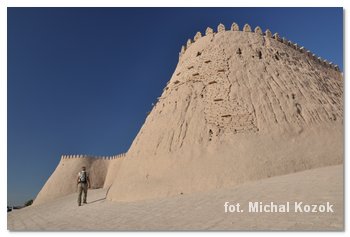 We were eating in the cheap bar in Khiva, where we sat down with two locals, which just have finished a bottle of vodka. After five minutes talking we were invited by Rashid to his home. We had the opportunity to see the fantastic Uzbek hospitality, for two days we felt like at home. In addition to delicious dishes we had to drink vodka with our host. Not from the glasses, but from the bowl, with the mandatory speech in the form of toast. Ewelina better speaks Russian, but I already understood a lot as well, so conversations were held until late. Khiva is one of the best preserved medieval towns, with winding mud streets, ornate doors, medressas, beautiful mosques and tall minarets. Old town (Ichon-Qala) is surrounded by city walls, where graves are located (in the past they supposed to stop the invaders - to respect the holy place).
We were eating in the cheap bar in Khiva, where we sat down with two locals, which just have finished a bottle of vodka. After five minutes talking we were invited by Rashid to his home. We had the opportunity to see the fantastic Uzbek hospitality, for two days we felt like at home. In addition to delicious dishes we had to drink vodka with our host. Not from the glasses, but from the bowl, with the mandatory speech in the form of toast. Ewelina better speaks Russian, but I already understood a lot as well, so conversations were held until late. Khiva is one of the best preserved medieval towns, with winding mud streets, ornate doors, medressas, beautiful mosques and tall minarets. Old town (Ichon-Qala) is surrounded by city walls, where graves are located (in the past they supposed to stop the invaders - to respect the holy place).
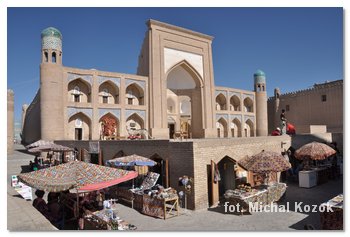 Whatever they will tell you at the gate – there is no need to buy any ticket if you do not want to enter the museums, you have the right to walk in the old town for free. You can buy one ticket valid in most places within two days (11.000 S normal or 9.000 S for students, 4/3 €, for camera you pay separately, sights are usually open till 6pm). Unfortunately for the most interesting attractions you have to pay extra anyway, so what's a sense to buy this ticket for 11,000 S? For me it's not fair, so we bought just one ticket and shared it, changing it the owner after each visit. But without a guide explaining what we are seeing, these museums are not really worth visiting. From the visited sights included in general ticket, the most I liked Juma Mosque, where you can see the room with 218 wooden columns. From the sights what you have to pay extra, the most I liked 57-meter high Islom-Hoja Minaret (2.000 S, 1.500 S student) during the sunrise, and at sunset I recommend the Oq tower
Whatever they will tell you at the gate – there is no need to buy any ticket if you do not want to enter the museums, you have the right to walk in the old town for free. You can buy one ticket valid in most places within two days (11.000 S normal or 9.000 S for students, 4/3 €, for camera you pay separately, sights are usually open till 6pm). Unfortunately for the most interesting attractions you have to pay extra anyway, so what's a sense to buy this ticket for 11,000 S? For me it's not fair, so we bought just one ticket and shared it, changing it the owner after each visit. But without a guide explaining what we are seeing, these museums are not really worth visiting. From the visited sights included in general ticket, the most I liked Juma Mosque, where you can see the room with 218 wooden columns. From the sights what you have to pay extra, the most I liked 57-meter high Islom-Hoja Minaret (2.000 S, 1.500 S student) during the sunrise, and at sunset I recommend the Oq tower 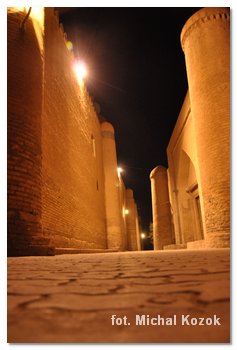 in Shihbobo Bastion (2.000 S, 1.000 S student) in the Kuhn Ark fortress complex (to enter the tower with a fantastic view on the walls, you first must get inside to the fortress - it can be done only with a general ticket). Was also quite nicely in the Mahmud Pahlavon Mausoleum (2.000 S, 1.000 S student). If you want to walk on the city walls for free, the easiest way is to climb it next to the north gate.
in Shihbobo Bastion (2.000 S, 1.000 S student) in the Kuhn Ark fortress complex (to enter the tower with a fantastic view on the walls, you first must get inside to the fortress - it can be done only with a general ticket). Was also quite nicely in the Mahmud Pahlavon Mausoleum (2.000 S, 1.000 S student). If you want to walk on the city walls for free, the easiest way is to climb it next to the north gate.
The main Pahlavon Mahmud Street is restored, including the unique square near the eastern gate (former slave market). But the side small streets are full of simple life with ordinary inhabitants. I admired lively daily atmosphere and calm evening with illuminated buildings. Although most of the town mosques are now the museums, and those religious functioning one call for praying is not allowed anymore (as in the whole Uzbekistan). Walking in the Khiva winding streets I felt like time has stopped here long ago. During the noon heat I recommend to hide in a cheap restaurant Rustamboy Chaikhana, LP, 100 meters from the spectacular western gateway.
Bukhara is located in the center of the Silk Road, at the crossroads from China, Byzantium, Persia and India. Despite the destructive Stalin's activities, there are still more than a dozen of old mosques, madressas, bazaars and caravanserais. However downside is their over-commercialization, inside most of them sells tourist souvenirs. There was the only place on our route, where children were begging for candies (in French). Many local names are in Tajik language - Tajikistan still claims that Bukhara and Samarkand is their towns - strange communist new borders caused the division, however, currently it is the Uzbekistan territory. About Internet cafes – they are fairly cheap, just 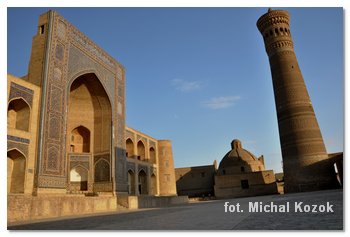 1.000 S per hour (in Khiva 2-3,000 S), but the trick is that only the first 10 MB download is free of charge. Then you pay an extra 50 S per 1 MB downloaded, and your account is growing even if you don't open any attachment, just simply surfing on websites. At the end of session an unpleasant surprise might waiting for you. Throughout Central Asia we met this situation only in Uzbekistan (Bukhara and Samarkand) and in Kyrgyzstan.
1.000 S per hour (in Khiva 2-3,000 S), but the trick is that only the first 10 MB download is free of charge. Then you pay an extra 50 S per 1 MB downloaded, and your account is growing even if you don't open any attachment, just simply surfing on websites. At the end of session an unpleasant surprise might waiting for you. Throughout Central Asia we met this situation only in Uzbekistan (Bukhara and Samarkand) and in Kyrgyzstan.
The most impressive building in Bukhara is the Ark (fortress), but reading reports about it we decided not to go inside - probably not worth it. We also admired the Mir-Arab Medressa (though entry for tourists in this university is prohibited). Opposite it is an interesting Kalon minaret and mosque, and after crossing the street north of the square is the local bazaar with huge beautiful carpets. Other worth seeing attractions are Abdul Aziz and Ulugbek Medressa, a Maghoki Attar Mosque, and located a little farther, but still charming little Char Minar. The town view at sunset we can see from the water tower, standing between the Ark and the Bolo-Hauz Mosque. View, however, it's not so impressive. Grandpa at the bottom charge you for the entrance, you will not get a ticket. Nightlife virtually doesn't exist around these places, but focused on the Lyabi Haouz Square - come here hungry, because it is full of pubs with tables outside.
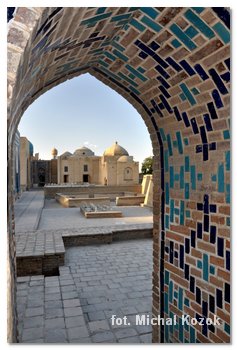 |
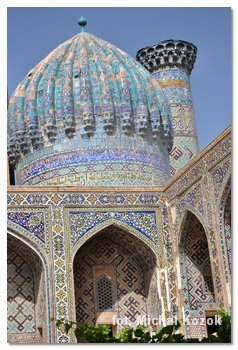 |
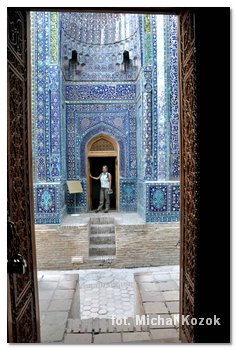 |
The highest architecture class can be seen in details in Samarkand, founded in the fourteenth century by Timur. Ryszard Kapuscinski wrote that there is no such animal which would be able to create something so beautiful, and at the same time be able to do so terrible things. Timur was such a beast. Only human is able to create masterpieces, while acting as a terrible tyrant and murderer. You do not need to be an art expert to wonder Samarkand mausoleums, mosques and medressas.
In contrast to Khiva and Bukhara, historical sights of Samarkand is far apart from each other. To reach the attractions you need to get through relatively modern city. The most we liked Registan and Shah-i-Zinda. Three extremely well preserved medressa's facades lying symmetrically opposite each other is called Registan. Ulugbek is the oldest one, founded in fifteenth century, the other two are from the seventeenth century. Walking inside the madressas could take a long time as there is a lot to admire - the azure glazed tilework and patterns on them, detailed finish domes, facades, portals etc. We can also see how student dormitories looked like. It should also pay attention to not 100% vertical walls and minarets - sometimes we can see how they leaning in different directions. Probably one of the guard-policeman will offer you climbng the minaret - the price will depend on your nationality and the overall impression of your wealth - we were told 5 $ per person, but for one American guy the negotiations started from 20 $. As for Uzbekistan the entry fee to the Registan is not the cheapest - 7.200 S per person (3 €) and there are no student discounts.
 Another building which particularly charmed us is the Shah-i-Zinda Mausoleum (The Tomb of the Living King). Open until late at night (other attractions in the city are closed usually around 6 pm), contains one alley which is set along the decorated tombs (Avenue of Mausoleums). At the end of the alley there is the Holiest Shrine of Qusam Ibn-Abbas - a cousin of the Prophet Muhammad (not 100% confirmed). In Samarkand as well quite impressing is the huge Bibi-Khanym Mosque (entry 4.200 S), but we looked on it just from the outside. Guri Amir Mausoleum (where tyrant Timur is buried) and the prophet Daniel Tomb does not deserve special notes from me - perhaps due to insufficient knowledge about them, and noisy renovation work on site.
Another building which particularly charmed us is the Shah-i-Zinda Mausoleum (The Tomb of the Living King). Open until late at night (other attractions in the city are closed usually around 6 pm), contains one alley which is set along the decorated tombs (Avenue of Mausoleums). At the end of the alley there is the Holiest Shrine of Qusam Ibn-Abbas - a cousin of the Prophet Muhammad (not 100% confirmed). In Samarkand as well quite impressing is the huge Bibi-Khanym Mosque (entry 4.200 S), but we looked on it just from the outside. Guri Amir Mausoleum (where tyrant Timur is buried) and the prophet Daniel Tomb does not deserve special notes from me - perhaps due to insufficient knowledge about them, and noisy renovation work on site.
From the three Uzbekistan Silk Road cities the most I liked Khiva, and then Samarkand. We completed the part of the journey associated with the Culture places. East from Samarkand starts the Nature: mountains, valleys and rivers - which will accompany us until the end of this adventure.
| town | site | price in S | €/ per | duration | note | comments |
| Monyaq | town museum | 1,000 S/ 2 per | €0.2 | 30' | ok | pay as much you wish |
| wracks on the beach | - | - | 1 h | worth | ||
| Khiva | old town museums entry fees | 9,000 S/ 2 per ISIC | €1.7 | 2 days | no good | normal ticket 11,000 S/ per or 9,000 S / student |
| Pahlavan Mahmud Mausoleum | 1,000 S/ ISIC | €0.4 | 15 min | ok | normal ticket 2,000 S | |
| Oq Shihbobo Bastion tower | 1,000 S/ ISIC | €0.4 | 15 min | worth | normal ticket 2,000 S, worth on the sunset | |
| Islom-Hoja Minaret | 1,500 S/ ISIC | €0.6 | 15 min | worth | normal ticket 2,000 S, worth on the sunrise | |
| Bukhara | water tower | 1,000 S/ ISIC | €0.4 | 15 min | no good | normal ticket 2,000 S, worth on the sunset |
| Samarkand | Shah-I-Zinda | 2,000*S | €0.8 | 1 h | worth | bargained from 3,000 S |
| Registan | 7,200*S/ 2 per | €1.4 | 1,5 h | worth | bargained, normal ticket 7,200 per person | |
| €6 |
![]()
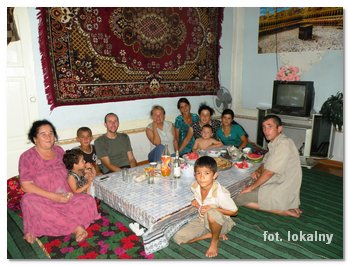 accommodation – accommodation price usually included simple but testy breakfast. When setting the price make sure which currency are you paying (dollars are gladly accepted), and which conversion will be used. When check out take back your registration card from the owner.
accommodation – accommodation price usually included simple but testy breakfast. When setting the price make sure which currency are you paying (dollars are gladly accepted), and which conversion will be used. When check out take back your registration card from the owner.
In Moynaq we can find Oybek Hotel (5 € per person, breakfast included), but conditions are poor. However, there are a lot of space around, so tent is a good alternative.
In Khiva it's much cheaper to stay outside the old city, as such in the guesthose located just few minutes walk to the north-west direction from the western gate. Located inside the old town Mirzoboshi B&B, recommended by LP, considerably have risen up the prices. I asked with curiosity about the double room – they started with 30 $.
In Samarkand, Bahodir B&B has an ideal location and a fantastic atmosphere with friendly service. It is not perfectly clean, but there is just a few minutes walk to the Registan and the minibus terminal to the Tajik border. Double room could be bargained down to 15 $ (11 €).
| town | hotel and address | N | accommodation | price per night | €/ per | note | comments |
| Bukhara | Saffron B&B, Saffron St. 4 | 1 | double room | 7 $/ per | €5.0 | 6 | breakfast |
| Samarkand | Bahodir B&B, LP, Mulokandov 132 | 1 | dormitory | 6 $/ per | €4.3 | 8 | breakfast |
| in wild | 2 | tent | |||||
| hospitality | 2 | ||||||
| 6 | €9 (2) |
![]()
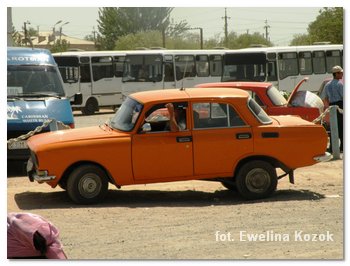 transport – during this trip only in Uzbekistan and Tajikistan I have seen drivers often bribing the police. The driver had to walk to the lazy officer and shake his hand or give him a driving license (depending on the region), during this operation hidden cash changed the owner. That very irritated me - why do they pay if they didn't do anything wrong? "That's how it is and end of story" – it was the most common response from the driver.
transport – during this trip only in Uzbekistan and Tajikistan I have seen drivers often bribing the police. The driver had to walk to the lazy officer and shake his hand or give him a driving license (depending on the region), during this operation hidden cash changed the owner. That very irritated me - why do they pay if they didn't do anything wrong? "That's how it is and end of story" – it was the most common response from the driver.
Urban transport usually cost between 200 and 300 S (0.1 €), even the shared taxis in Moynaq.
| day | destination | transport | price in S | €/ per | duration | km |
| 20 | Turkmenistan border - Khojayli | shared taxi | 1 $/ per | €0.7 | 20' | 15 |
| 20 | Khojayli - Qonghirat | bus | 2000 S | €0.8 | 2 h | 106 |
| 20 | Qonghirat - Moynaq | bus | 2000 S | €0.8 | 1.5 h | 83 |
| 21 | Moynaq - Qonghirat | minibus | 3000 S | €1.2 | 1 h | 83 |
| 21 | Qonghirat - Nukus | bus | 2000 S | €0.8 | 2 h | 134 |
| 21 | Nukus - Beruniy - Urganch | 2x minibus | 5000 S | €1.9 | 1.5 h + 30' | 140 + 25 |
| 21 | Urganch - Khiva | taxi | 4500 S/ 3per | €0.6 | 30' | 28 |
| 23 | Khiva - Bukhara | bus | 10,000 S | €3.8 | 7 h | 470 |
| 25 | Bukhara - Samarkand | bus | 6000 S | €2.3 | 4.5 h | 268 |
| 26 | Samarkand - Taijikistan border | minibus | 3000 S | €1.2 | 50 ' | 35 |
| city transport | taxi, bus, minibus | 1500 S/ per | €0.6 | - | - | |
| €15 | 1387 |
![]()
 visa – we arranged our visas through an agency, in our case it was probably the best option. It was the most expensive visa in my life – 70 $ (single entry, valid for 14 days), plus letter of invitation (LOI) for 95 $, and agency commission (in our case 19 $ per person). For LOI usually you are waiting around a week (but they don't block a passport) and to obtain the visa shouldn't be more than 3 days. Unfortunately the enter and exit dates of your visa must be filled at time of application – visa is not valid from the entry day, but from the fixed dates which you applied – no good idea if you like travelling style “go with the flow”. You can buy cheaper or more expensive visas, depends on period and number of entries (most common one from 60 $ to 100 $).
visa – we arranged our visas through an agency, in our case it was probably the best option. It was the most expensive visa in my life – 70 $ (single entry, valid for 14 days), plus letter of invitation (LOI) for 95 $, and agency commission (in our case 19 $ per person). For LOI usually you are waiting around a week (but they don't block a passport) and to obtain the visa shouldn't be more than 3 days. Unfortunately the enter and exit dates of your visa must be filled at time of application – visa is not valid from the entry day, but from the fixed dates which you applied – no good idea if you like travelling style “go with the flow”. You can buy cheaper or more expensive visas, depends on period and number of entries (most common one from 60 $ to 100 $).
If you want to arrange the formalities by yourself, you first need to arrange a letter of invitation. You might find helpful agencies on the Internet, but there is a problem with transferring the money and trust company located thousands of kilometers away from you. If you do not plan to spend too much time in Uzbekistan, much cheaper alternative might be to apply for 1-3 days transit visa (40-50 $, no need of LOI, but then you first need a visa to the destination country).
Uzbekistan has embassies in most countries of the former USSR, as well as in France, Germany and Great Britain.